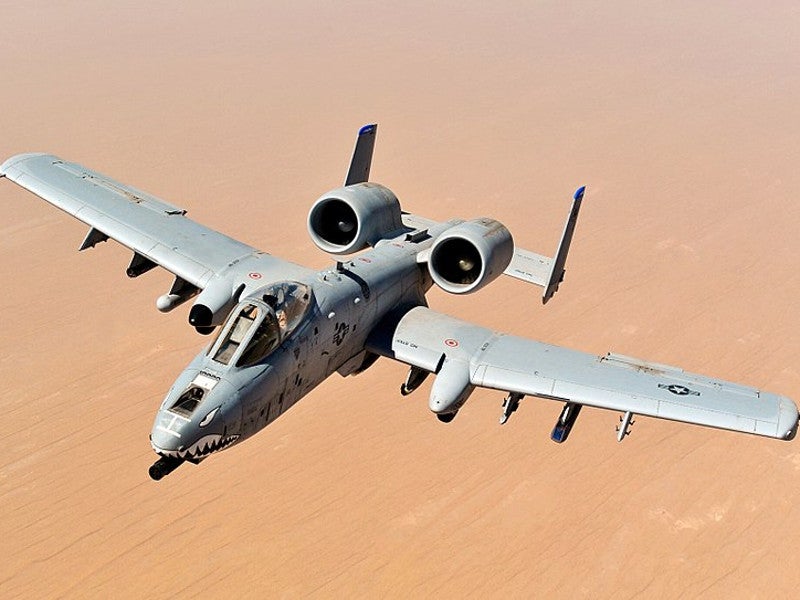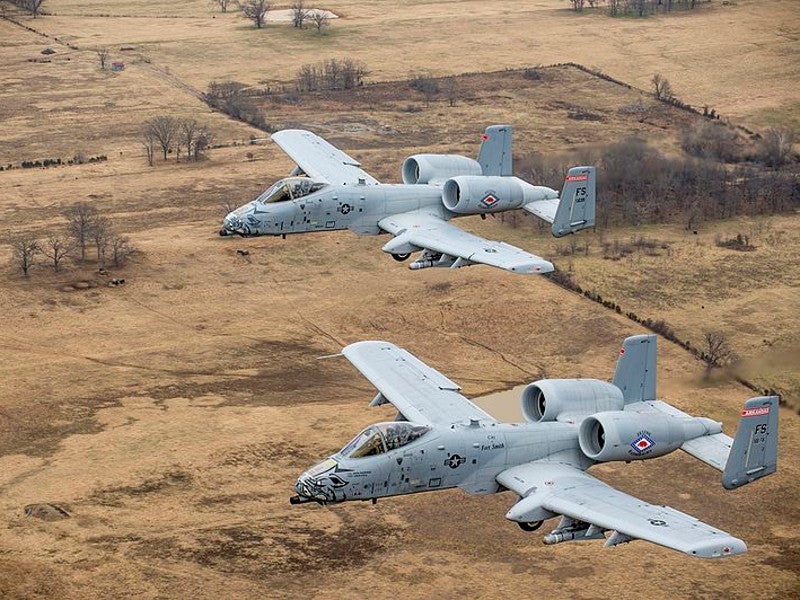The A-10 Thunderbolt is a twin-engine close air support aircraft manufactured by Fairchild Republic, now part of Northrop Grumman, for the US Air Force (USAF).
Also known as the Warthog, the ‘flying gun’ and the Tankbuster, the aircraft was used extensively during Operation Desert Storm, in support of Nato operations in response to the Kosovo crisis, as well as in Operation Enduring Freedom in Afghanistan, and Operation Iraqi Freedom.
The A-10 is a high-survivability and versatile military aircraft, popular with pilots for its ‘get home’ effectiveness.
The aircraft’s mission is ground attacks against tanks, armoured vehicles and installations, along with close air support of ground forces.
A total of 281 A-10 aircraft are in service with the USAF, Air Combat Command (ACC), Air Force Reserve, and the Air National Guard (ANG). The aircraft variants currently in service in the USAF are A-10, and A-10C; Reserve A-10 and OA-10; ANG, A-10, and OA-10.
The US Congress approved the USAF’s request to undertake a planned divestment of the A-10 aircraft in the Fiscal Year 2023 National Defense Authorization Act (NDAA) in December 2022.
The move came after Congress stalled multiple attempts by the USAF to retire the A-10 in recent years. The USAF is of the view that the ageing aircraft is difficult to maintain and intends to use the funds allocated for its maintenance and upkeep to rather procure modern aircraft.
A-10 Thunderbolt development details
The first flight of the A-10 was in May 1972, and a total of 713 aircraft were produced. The production of the A-10 came to an end in 1984. The aircraft was originally manufactured by Fairchild Republic, now part of Northrop Grumman, which has been the prime contractor for the A-10 since 1987. Northrop Grumman has been performing support and structural upgrade programmes from the Integrated Systems and Aerostructures Divisions at Bethpage, New York; and St Augustine, Florida.
The A-10A achieved its initial operating capability (IOC) in 1977 while the A-10C achieved IOC in 2007.
Boeing was awarded a $2bn contract for the A-10 wing replacement programme in June 2007. The USAF exercised an option for 56 replacement wings in September 2013 to increase the total number of aircraft under the programme to 173. The installation of the new wings for the last of the 173 aircraft was completed at Hill Air Force Base in Utah in August 2019. The new wings have enhanced durability and efficiency.
In September 2009, the USAF awarded two contracts worth $4.2m to Boeing for modernising its fleet of 365 A-10 Thunderbolt II aircraft for a period of three to 18 months. The contract was awarded as part of the total $1.6bn A-10 Thunderbolt life-cycle programme support (TLPS) contract.
The first contract included the A-10 Aircraft Structural Integrity Program (ASIP), which involved the provision of engineering services for the aircraft. Executed by Boeing and Southwest Research Institute (SwRI), it focused on updating and aligning modern structural analysis tools, processes and standards for the A-10 fleet. The second contract included trade study analysis and operational assessment/proof of concept for the upgraded data transfer unit (UDTU). Performed by Boeing, Raytheon Technical Services, and BAE Systems Platform Solutions, the contract aimed at upgrading the aircraft’s avionics architecture to improve memory and data capability.
Boeing received a $999m contract from the USAF for delivering sustainment work on the A-10 Thunderbolt II aircraft, in August 2019. The 11-year contract will involve managing the production of 112 new A-10 wing assemblies and 15 wing kits. Boeing partnered with Korean Aerospace Industries and other key suppliers to deliver services under the contract. The first wing set under the contract was delivered in May 2022.
Boeing selected CPI Aerostructures (CPI Aero) to provide structural assemblies for the A-10 aircraft’s wing replacement programme, in October 2019.
Kaman Aerospace Group received a contract from Boeing for the manufacture of wing control surfaces and structural assemblies for the A-10 re-winging programme in November 2019. The contractual scope includes the supply of inboard and outboard flaps, slats, and deceleron/speed brake assemblies, including speed brakes, trim tabs, and edge assemblies.
The company delivered flight control surfaces to Boeing for 173 aircraft under a previous contract for the wing replacement programme.
The Southwest Research Institute (SwRI) and Sabreliner Aviation were awarded a $1m contract by the USAF in August 2020 to continue structural analysis and maintenance work of the A-10 Thunderbolt II aircraft fleet.
Raytheon Intelligence & Space (RI&S), a business unit of Raytheon Technologies, was selected for a $46.2m project-level agreement to modernise the A-10 in June 2022.
The company will replace the existing mission computer of the aircraft with its Common Open Secure Mission Computer (COSMC), which will provide enhanced processing capabilities to combat and weapons systems, enabling air dominance and sustainability of the aircraft.
RI&S was selected for phase one of a multi-phase prototype project, with a potential contract expected to be awarded for the production and installation of the COSMC.
Terma North America received a $60m contract in October 2019 to supply a new 3D audio system for the A-10 in service with ANG, Air Force Reserve Command, and ACC. Expected to be completed by 2024, the contract includes the supply, installation, and support of the Terma Aircraft Audio Management System (AAMS), including Terma 3D audio and active noise reduction (ANR) system. The AAMS will replace the legacy audio management system. It can provide audio warnings/cues and radio messages to the pilot in a 360° spherical representation to enhance situational awareness and reduce stress.
An A-10C Thunderbolt II carried small-diameter bombs during a test near Eglin Air Force Base, Florida, in February 2022.
A-10C precision engagement upgrade programme
The precision engagement upgrade programme for the A-10 includes enhanced precision target engagement capabilities, which allow the deployment of precision weapons such as joint direct attack munition (JDAM) and wind-corrected munitions dispenser (WCMD), as well as enabling an extension of the aircraft’s service life to 2028.
Improvements include hands-on throttle and stick control, two new Raytheon Technical Services 5in×5in multifunction cockpit displays, situational awareness datalinks (SADL), digital stores management system, an integrated flight and fire control computer (IFFCC) from BAE Systems Platform Solutions for automated continuously computed weapons delivery, Sniper XR or Litening targeting pods for precision-guided weapons and a helmet-mounted sighting system.
Lockheed Martin Systems Integration-Owego was the prime contractor for the programme. The first flight of the upgraded A-10C took place in January 2005. A contract for low-rate initial production (LRIP) of 72 units was awarded in March 2005. The first unit was delivered to Baltimore Air National Guard in August 2006.
A contract for full-rate production of 107 units was placed in August 2006. The A-10C achieved initial operating capability in August 2007. A total of 100 A-10s had been upgraded by January 2008. Operational deployment of the A10C in Iraq began in September 2007. A total of 356 A-10 aircraft were upgraded under the contract.
In February 2004, Lockheed Martin was awarded a contract for the integration of the Sniper XR targeting pod on the A-10 as part of the PE programme. Sniper XR includes mid-wave FLIR (forward-looking infrared), dual-mode laser, CCD-TV, laser spot tracker and IR marker.
Mission capabilities of the A-10
The A-10 is suitable for operation from forward air bases, with short take-off and landing capability. The aircraft has a long range and high endurance and can loiter in the battle area for an extended period of time. It can land in austere conditions and operate.
The manoeuvrability at low speed and low altitude (below 1,000ft) with 2.4km visibility allows accurate and effective targeting and weapon delivery over all terrain types.
A-10 Thunderbolt cockpit detail
The single-seat cockpit is protected by all-round armour, with a titanium ‘bathtub’ structure up to 3.8cm thick to protect the pilot. The cockpit has a large bulletproof bubble canopy, which gives good all-round vision.
The cockpit is equipped with a head-up display, which is used for targeting and weapon aiming, a Have-Quick secure radio communications system, inertial navigation, and a tactical air navigation (TACAN) system.
The A-10 aircraft was upgraded with the embedded global positioning system / inertial navigation system (EGI), which pinpoints the exact location of the aircraft. It is also fitted with BAE Systems terrain profile matching systems (TERPROM).
The pilot is equipped with night-vision goggles and the infrared imaging display of the Maverick AGM-65.
Weapons of the A-10
The A-10 aircraft has 11 store pylons, providing an external load capacity of 7,260kg. Three pylons are under the fuselage and the loads can be configured to use either the centre-line pylon or the two flanking fuselage pylons.
For weapon guidance, the aircraft can be fitted with Pave Penny laser guidance / electronic support measures, and a pod installed on the starboard fuselage pylon. Each wing carries four store pylons: three outboard and one inboard of the wheel fairing.
The A-10 can carry up to ten Maverick air-to-surface missiles. The Raytheon Maverick AGM-65 missile uses a variety of guidance systems, including imaging infrared guidance and warheads, which include a high-penetration, 57kg conical-shaped charge warhead. The range is more than 45km.
The aircraft can also carry the Sidewinder air-to-air missile, which is an all-aspect short-range missile with a maximum speed exceeding Mach 2, and 2.75in rockets.
The A10 is capable of deploying a wide range of ordnance such as the LDGP Mk82 226kg, 900kg Mk-84 series low/high drag bombs, 226kg general-purpose bombs, BLU-1 and BLU-27/B Rockeye II cluster bombs, cluster bomb unit CBU-52/71, combined effects munitions, and mine dispensing munitions. It can also carry laser-guided/electro-optically guided bombs, infrared countermeasure flares, electronic countermeasure chaff, illumination flares, and jammer pods.
The Northrop Grumman Litening ER (extended range) targeting pod has been successfully integrated on the A-10. The Litening ER features a 640×512 pixel thermal imager, CCD TV, laser spot tracker/rangefinder, IR marker and laser designator.
The aircraft is armed with a General Dynamics GAU-8/A Avenger 30mm cannon mounted in the nose of the aircraft.
Using the cannon, the A-10 can disable a main battle tank from a range of more than 6,500m. The cannon can fire a range of ammunition, including armour-piercing incendiary rounds (API) weighing up to 0.75kg, or uranium-depleted 0.43kg API rounds.
The magazine can hold 1,350 rounds of ammunition. The pilot can select a firing rate of either 2,100 or 4,200 rounds a minute.
Engines and performance of the A-10 aircraft
The two TF34-GE-100 non-afterburning turbofan engines, supplied by General Electric, each provide 9,065lb of thrust. The location of the engines, high on the fuselage, allows the pilot to fly the aircraft with one inoperable engine.
The aircraft has a standard range of 800 miles (1,287km) and a maximum speed of 420 miles per hour (Mach 0.56). It can reach an altitude of 45,000ft (13,636m).






